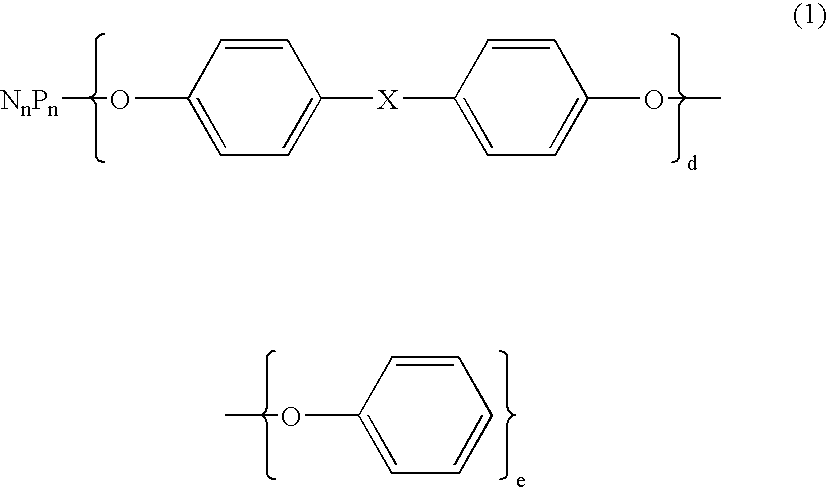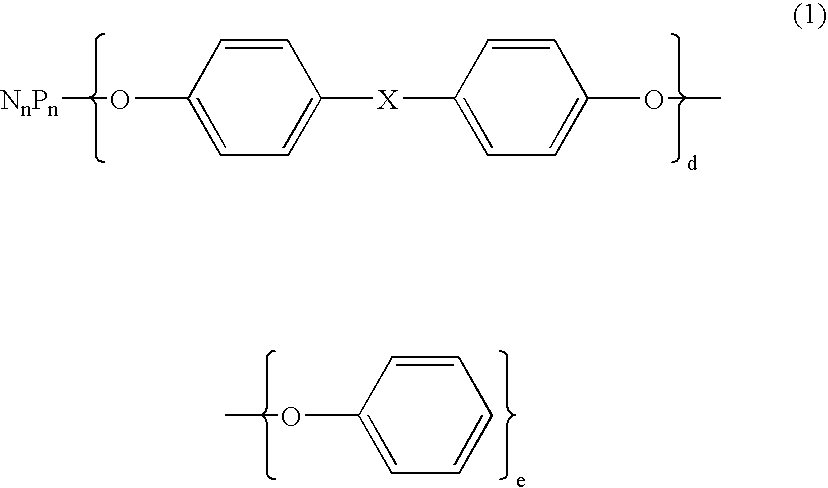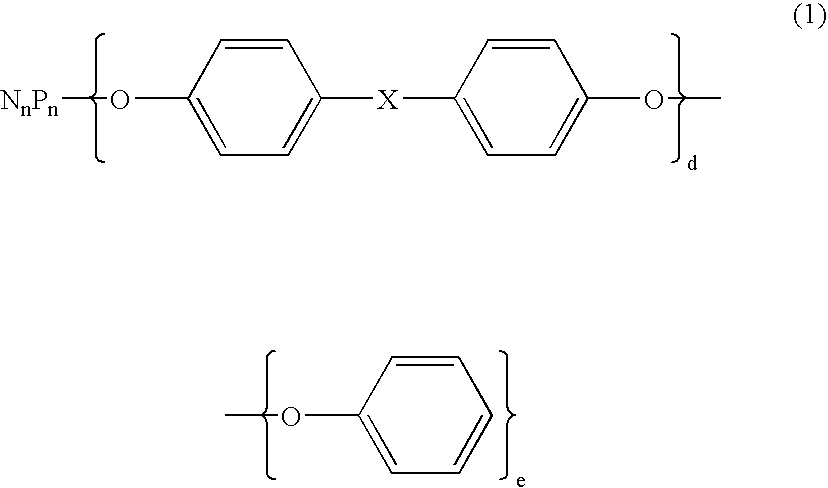Flame retardant and an epoxy resin composition comprising the same for encapsulating semiconductor devices
a technology of epoxy resin and flame retardant, which is applied in the field of flame retardant, can solve the problems of antimony trioxide being hazardous, affecting the heat resistance of a semiconductor device encapsulated with a composition comprising the brominated epoxy resin, and releasing poisonous gas in the resin, so as to prevent the hydrolysis of phosphazene and not affect the reliability of the semiconductor devi
- Summary
- Abstract
- Description
- Claims
- Application Information
AI Technical Summary
Benefits of technology
Problems solved by technology
Method used
Image
Examples
synthesis example 1
[0059] In nitrogen atmosphere, 8.6 g (214 mmol) of sodium hydride was suspended in 50 ml of THF at 0° C. To the suspension, a solution of 19.8 g (211 mmol) of phenol dissolved in 75 ml of THF was added dropwise and stirred for 30 minutes. To the mixture obtained, a solution of 12.0 g (34.5 mmol) of hexachlorotriphosphazene in 75 ml of THF was added dropwise and heated under reflux for 18 hours. After THF was distilled off at a reduced pressure, methanol was added to the distillation residue. Crystals precipitated were washed with methanol and water, and 23.8 g of white crystals of phosphazene compound A-1 represented by the following formula was obtained.
synthesis example 2
Phosphazene Compound B-1
[0060] In nitrogen atmosphere, 4.8 g (119 mmol) of sodium hydride was suspended in 50 ml of THF at 0° C. To the suspension, a solution of 10.2 g (108 mmol) of phenol and 0.45 g (1.8 mol) of 4,4′-sulfonyldiphenol dissolved in 50 ml of THF was added dropwise and stirred for 30 minutes. To the mixture obtained, a solution of 12.5 g (36.0 mmol) of hexachlorotriphosphazene in 50 ml of THF was added dropwise and heated under reflux for 5 hours. To the mixture obtained, a suspension prepared by suspending 5.2 g (130 mmol) of sodium hydride in 50 ml of THF at 0° C. was added dropwise and then a solution of 11.2 g (119 mmol) of phenol in 50 ml THF was added dropwise, and heated for another 19 hours under reflux. After THF was distilled off at a reduced pressure, chlorobenzene was added to dissolve the distillation residue. The solution obtained was extracted with 200 ml of 5% NaOH aqueous solution for 2 times, 200 ml of 5% H2SO4 aqueous solution for 2 times, 200 ml o...
example 1
[0061] In a vacuum chamber, 50 parts by weight of porous silica fine particles, SS-150, ex Mitsubishi Rayon Co., Ltd., having a mean particle size of 8.8 μm and a specific surface area of 155 m2 / g were placed. A solution of the phosphazene compound A-1 was prepared by dissolving 40 parts by weight of the phosphazene compound A-1 in 100 parts by weight of acetone. Separately, an epoxy resin solution was prepared by dissolving 6 parts by weight of an epoxy resin, GTR-1800, ex Nippon Kayaku Co., Ltd., 4 parts by weight of a curing agent, MEH-7500, ex Meiwa Plastic Industries, Ltd., and 0.3 part by weight of triphenylphosphine in 100 parts by weight of acetone.
[0062] To the silica fine particles, 140 parts by weight of the aforesaid solution of A-1 was added dropwise through a sealed port of the chamber and left to stand for 30 minutes, and then stirred for 30 minutes to allow the solution to impregnate the porous silica fine particle. Then, the pressure inside the chamber was returned...
PUM
| Property | Measurement | Unit |
|---|---|---|
| temperature | aaaaa | aaaaa |
| temperature | aaaaa | aaaaa |
| temperature | aaaaa | aaaaa |
Abstract
Description
Claims
Application Information
 Login to View More
Login to View More - R&D
- Intellectual Property
- Life Sciences
- Materials
- Tech Scout
- Unparalleled Data Quality
- Higher Quality Content
- 60% Fewer Hallucinations
Browse by: Latest US Patents, China's latest patents, Technical Efficacy Thesaurus, Application Domain, Technology Topic, Popular Technical Reports.
© 2025 PatSnap. All rights reserved.Legal|Privacy policy|Modern Slavery Act Transparency Statement|Sitemap|About US| Contact US: help@patsnap.com



